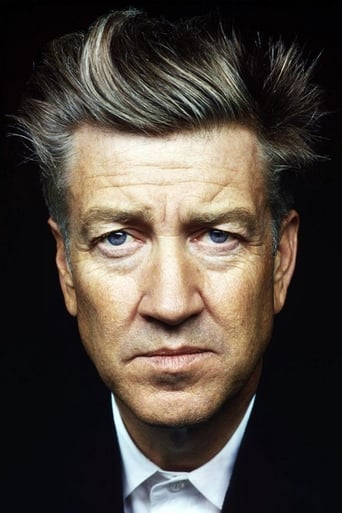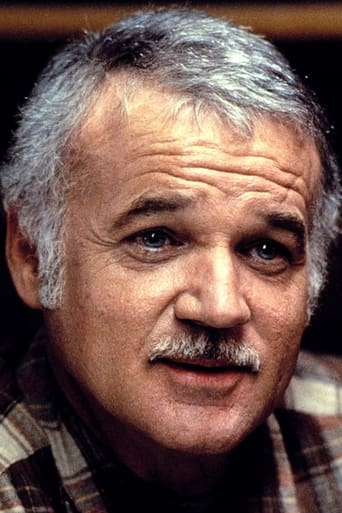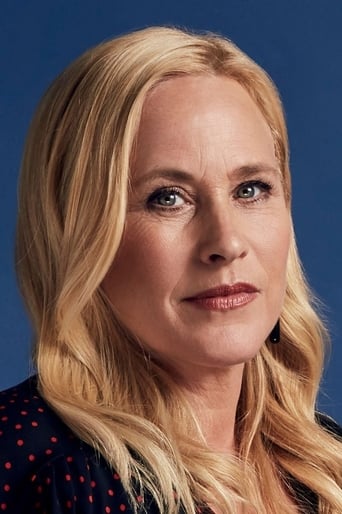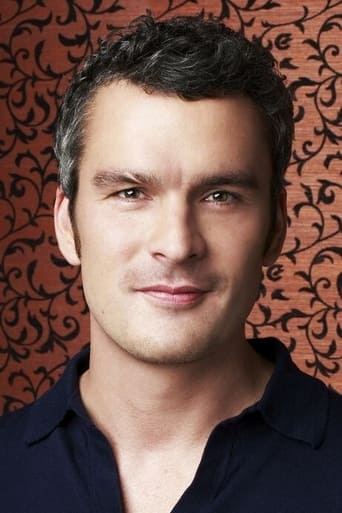Alicia
I love this movie so much
Acensbart
Excellent but underrated film
Beystiman
It's fun, it's light, [but] it has a hard time when its tries to get heavy.
Erica Derrick
By the time the dramatic fireworks start popping off, each one feels earned.
MisterWhiplash
Toby Keeler, with his unlimited access to David Lynch- behind the scenes during his films, with friends and family and collaborators, and in his painting process- has a documentary that's essential to get at least a glimpse into a man and his work like this. Lynch's films are abstractions, nightmarish landscapes and what is just around the corner in the seemingly brightest sides of small-town American life, and his art is a reflection not just of his own interpretations of people and places that are usually conventional, but that this interpretation springs out so many ideas that would not be there otherwise without the specific framework he's chosen. One of the most fascinating examples of this method of Lynch's in being a true master of mood is with Eraserhead; he worked five years on the film, and Keeler shows us Lynch and old friends walking around where the original sets were, and with this revealing how after two years of painstakingly filming a movie (a shot a night, nevermind a scene, depending on the lighting), a rhythm developed that was unmistakable. If one of the primary goals of an artist is to transport people to another place that is unconventional, but still grounded in recognizable emotional connections, Lynch is such an artist, as revealed here fully.Of course, as collaborator Barry Gifford explains at one point, Lynch is very complex. On the outside he's an "all-American" type of guy, affable, well-mannered, coffee drinking and cigarette smoking, into building lots of things aside from his methods of making painting (what could be considered two sides to a coin of enjoying making 'things', we see Lynch using bugs to actually assist in making a painting, and Lynch himself creating many of the furniture pieces used in Lost Highway). But beneath this exterior image is someone who is so in touch with the dark side of human nature that it almost has to come out in the way it does in his films. From looking at clips shown in Pretty as a Picture, be they clips from his early short films like the Grandmother or the Alphabet, or even just little scenes from Lost Highway, one might think that Lynch is loony as a tune (that's how I thought of him early on, just on perceptions from Eraserhead and Blue Velvet). It's something of an assuring, if a little over-stated in adulation, to hear that he's consummate as an artist and professional director, with the one surprisingly the most saying this is the producer of Lost Highway.For fans, to be sure, there's lots to soak in here, like seeing the little details in the process of scoring the film with Badalamenti (each note carefully considered), or in hearing the Frank DaSilva story regarding his appearance in the Twin Peaks pilot (or, speaking of TP, the soap in the coffee filter story). Seeing him in action filming is fascinating in that, in a way, there's nothing much out of the ordinary how he works, and if anything he almost seems passive, however always in control of every detail (i.e. the death-row set). But Keeler also is wise to make this documentary appealing to people who aren't very aware of Lynch's paintings and the process with them. It might be easy, as spotting someone into surrealism like Lynch, to peg him as such simply for the obsession with the bugs. Yet there's more than just that aspect for Lynch, as there's a sense captured about Lynch of taking everything seriously- especially mistakes- for what it can be worth emotionally not just with the end product but in putting all of it together. And, in a way, looking at a Lynch painting or photo (which one person describes as Lynch trying to get a painting to "move" as it were), one gets a sense of how an artist in general tries to achieve something of merit, if only on a personal level that might not even reach most people.Pretty as a Picture is at least worthwhile for anyone who's ever been all too long in the world of Lynch- the X family's house, the black lodge, Winkies, the apartment in Blue Velvet- but it's also made to be appealing (as far as Keeler can make it, as he isn't usually a documentary filmmaker) for non-fans as well, to get both a general and a specific sense of what the man can do with the materials he wants to work with. Quite frankly, if he wanted to film a fax machine I'd want to watch it; it's probably not without reason he would film it too, depending on the idea of the moment.
Andrew Leavold
David Lynch went to visit friends for the weekend. Struck by artistic inspiration, he found a dead mouse which he glued to a plate, and collected a huge plastic bag full of flies for a future painting. When he returned home he discovered he'd forgotten his luggage. He described the contents of his bag to an incredulous courier over the phone; the bag was dumped on his doorstep, and before he could open his front door the delivery van had fled.Toby Keeler's documentary Pretty As A Picture is crammed with such Lynchian oddities. Keeler should know them well - they have been friends and collaborators since Eraserhead (Keeler is billed as 'Fighting Man') in the early '70s. His cameras take us behind Lynch's cryptic masterwork Lost Highway, and he interviews key figures in the Lynch pantheon (including Blue Velvet's Dean Stockwell and Elephant Man producer Mel Brooks). Pretty As A Picture is billed as an 'authorised' biography. On the phone from Las Vegas, Keeler explains the tag: `I had to keep running it past David. I think I showed it to him three or four times - he kept saying 'Well, Toby, can we put in...'!'Keeler has worked in the documentary field for thirty years, and his experienced eye is evident in the sharp focus on his subject. Lost Highway cast and crew take great pains to point out David is just a gee-whiz mom-and-apple-pie kind of guy totally at odds with his 'King of Weird' persona. But Keeler's picture of Lynch shows an affable guy with a loopy sense of wonder about him who happens to be completely absorbed in his art. His obsession with textures and impressions explain why he is an artist first and filmmaker second, and why his films' narratives tend to fly out the window.Pretty As A Picture captures the PeeWee's Playhouse atmosphere of Lynch film sets. One poignant moment is the cast and crew's reunion at the site of Eraserhead's concrete mausoleum, showing the hair-raising Jack Nance (now bald) laughing and joking with the rest, just months before his tragic murder.`I didn't set out to cover every movie, that's been done before,' says Keeler. `I didn't want to do a 'Behind the Scenes' documentary. What I wanted to achieve was a glimpse of Lynch as a serious artist at work.' Keeler succeeds. Pretty As A Picture is neither definitive Lynch or an insipid studio 'Making of...', but a series of fragments that make the picture whole: Lynch as a modern day Frankenstein totally immersed in the process of creation.
Billy Z Duke (billyzduke)
Using mostly interview and set footage culled from the production of Lost Highway, this documentary takes a look at Lynch so broad and unfocused that it will provide few revelations for the die-hard fan (like myself) who is obviously the target audience. Sure, it's moderately amusing to see Lynch and company (including the late Jack Nance) revisit the Eraserhead set years later, and neat to watch him work on his paintings (one containing the corpses of a rat and a bird, as well as a large slab of meat being devoured by ants), but the overall feel is of leftover footage cobbled together, which never inspires or disturbs anywhere near the degree achieved by his actual works.Why this has been released on DVD before Eraserhead and Lost Highway is a mystery to me. The book Lynch on Lynch covers everything this does and in much greater detail.
Michael Sean
Comprised mostly of footage and interviews shot during the making of "Lost Highway," this excellent documentary provides a fascinating peek inside the world of the master filmmaker and his entourage of collaborators. Besides some amusing anecdotes from David himself, there's chats with his ex-wife Peggy, his children (including budding director Jennifer Lynch), his friend Jack Fisk, editor Mary Sweeney, producer Mel Brooks, writer Barry Gifford, actor Dean Stockwell, and "Eraserhead"/"Twin Peaks" almuni Jack Nance and Catherine Coulson. We also hear from the cast members of "Lost Highway," as well as learn the stories behind some of Lynch's characters (Bob, The Log Lady, Frank Booth, Mr. Eddy). Some of the more illuminating moments come when the focus shifts to his non-film projects, including some great footage of him working with composer Angelo Badalamenti and singer/violinist Jocelyn Montgomery (billed as Jocelyn West) on the unreleased track "And Still." His bizarre multimedia paintings are discussed, and there's a visit to a gallery show of his photography. He also created all of the furniture used in "Lost Highway." and we see a showcase of the odd tables and shelves he's made. The DVD edition outshines the shorter VHS version, with additional footage (with some Twin Peaks coverage) plus nice menu screens featuring clips from "Eraserhead,""Lost Highway," and his two early short films "The Grandmother" and "The Alphabet." All in all, any fan of the man's movies will want to check this one out. It's an interesting and inspiring portrait of a real American iconoclast.





